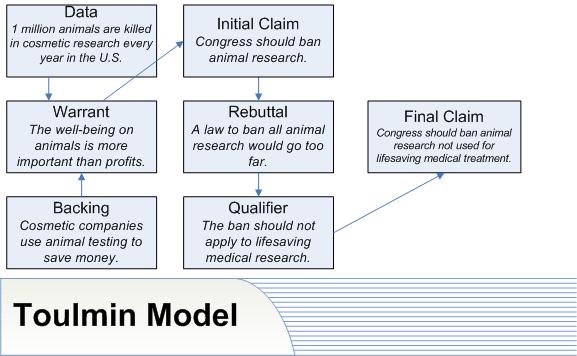Toulmin developed his theory of argumentation because of what he viewed as an inherent problem with formal logic. Put simply, Toulmin recognized what every person should already know: Real people do not argue in syllogisms. You may remember from a philosophy class that a syllogism is a form of logical argument. According to rules of logic, if an audience accepts both the major and minor premises of a syllogism, they must accept the conclusions. For instance, many people are familiar with the following example of a syllogism:
- Major Premise: All men are mortal,
- Minor Premise: Socrates was a man,
- Conclusion: Socrates is mortal.
Toulmin realized that this form of argumentation is not what one encounters when listening to a public speech, arguing with a roommate about what music to listen to, or talking politics at a bar. Consequently, Toulmin developed his theory in order to explain how argumentation occurs in the natural process of everyday argument. Consequently, Toulmin wanted to explain how real people (not philosophers) argue.
Although Toulmin's position on formal logic -- that formal rules of logic do not fit well with common practices of argument -- may seem obvious, one must remember the time period in which Toulmin developed his theory. Students of public speaking, rhetoric, and logic were only taught formal logic. Using a contemporary example to illustrate: Students were taught how to program a computer before they were taught how to click a mouse. When one recognizes the traditions of the time period, Toulmin's theory of argument seems even more revolutionary.
The Toulmin Model of Argument-Basics

Claim
Think of the claim in an argument as the most general statement in the argument. It may not be a particularly general statement all by itself, and some claims for arguments are very narrow. But the claim in an argument is like the umbrella statement that all other parts of an argument have to fall under. If a reason (or evidence) doesn't fall under the umbrella of the claim, then it’s irrelevant.
Warrants
These are the assumptions or presuppositions underlying the argument. Warrants are generally accepted beliefs and values, common ways our culture or society views things; because they are so commonplace, warrants are almost always unstated and implied. The author and audience may either share these beliefs, or the author’s warrants may be in conflict with audience’s generally held beliefs and cultural norms and values. Warrants are important because they are the "common ground" of author and audience; shared warrants invite the audience to participate by unconsciously supplying part of the argument. Warrants are also important because they provide the underlying reasons linking the claim and the support. You can infer the warrants by asking, "What’s causing the author to say the things s/he does" or "Where’s the author coming from"
Data
Data is the information that generates the claim in theory. More often, it is searched for after the claim is provided.
- “the evidence, facts, data, and information that are the reason for the claim in the first place- a reasoned beginning” (Ross, 1985).
- Data is significant because it establishes the basis of the argument. In effect, the data is the starting point from which all sound arguments must begin.
- Types of Data: Anecdotal, Testimony, Statistics
Rebuttal
The Rebuttal (or Reservation) is an exception to the claim presented by the arguer. In Toulmin’s model, arguments are not considered to be true without analysis. The rebuttal demonstrates how arguments can be strengthened (and made more correct) by acknowledging the limits of the argument.
Qualifier
The Qualifier is recognition of the rebuttal. After analyzing one’s argument and acknowledging its limits, the rhetor should signify his/her new statement with the qualifier statement. Qualifiers are often words like
The Toulmin model is both a method of analyzing the argument of others and developing the soundness of one’s own argument. A useful technique to develop sound argument is to run one’s argument through the model until the claim is true.
Sources
Additional Resources
Comments (0)
You don't have permission to comment on this page.